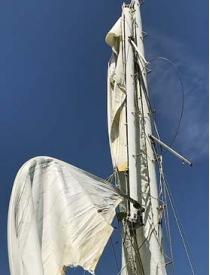As UK MAIB reports in its most recent Safety Digest, it was a glorious early summer’s day with perfect wind conditions in which to set sail for a classic yacht regatta. The yacht was making good progress under sail, tacking to port on an autopilot-controlled south-westerly course.
The yacht was equipped with a chart plotter magnetic compass and a radar, which was turned off. The skipper saw that all was clear and went below to prepare lunch, while the other crew member, who was also an experienced sailor, took over the watch. At the same time, a dredger was on a north-easterly course at a speed of around 4kts and about two points on the yacht’s starboard bow. On the bridge, the sole officer of the watch (OOW) was navigating using paper chart,
Electronic Chart Display and Information System (ECDIS) and radar, as well as monitoring the automatic identification system (AIS). The OOW then went to help a crew member with some administrative work at the back of the bridge.The yacht watchkeeper had been alone at the helm for about 10 minutes when they saw the dredger come into view from behind the yacht’s sails, closing fine on the yacht’s starboard bow and on a heading to cross to port. The watchkeeper shouted a warning to the skipper before disengaging the autopilot and putting the tiller hard over to starboard to avoid a head-on collision. The skipper immediately took command on returning to the deck but could not prevent the yacht from colliding with the dredger’s bow.
The yacht scraped along the port side of the dredger, damaging its masts and sails as it did so, but fortunately remained afloat. The dredger’s crew rendered assistance before the yacht made its way back to port.

Lessons learned
- Lookout → The dredger’s OOW had become distracted from their primary function of keeping a proper lookout to help a colleague. The OOW was relying on the dredger’s ECDIS, radar and AIS to alert them to other vessels, but the yacht did not have an AIS transmitter and might not have been detectable on radar. Besides traffic avoidance, keeping a proper all-round lookout is vital to verify the navigational position of the vessel. A lone watchkeeper’s understanding of a situation can be greatly improved by additional assistance from a dedicated lookout.
- Monitor → Navigation can be like driving a car: regardless of how much care you take, it is sometimes the actions of other users that can cause you problems. The yacht was well-equipped for a coastal passage and had many navigational aids, including a radar. However, the skipper had chosen not to use it on this clear summer’s day and so reduced the watchkeeping options to a visual lookout only. The sails were carried on the starboard side of the vessel on the port tack, creating a natural blind sector that reduced the watchkeeper’s view to starboard. It is essential that watchkeepers identify when a blind sector is presented or created and take early action, periodically assessing the risk and implementing measures in sufficient time to avoid a collision.
- Action → On sighting the dredger, the yacht watchkeeper in this case acted promptly to alert the skipper below and take corrective avoiding action. Lone watchkeepers must be fully briefed and capable of taking the correct action if required to do so when left in charge. It could turn out to be lifesaving.






























































